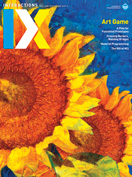Authors:
Robert Cameron, Andrei Smolik, Kevin Lefeuvre, Albrecht Kurze, Sören Totzauer, Michael Storz, Andreas Bischof, Arne Berger, Mathieu Goc, Lawrence Kim, Ali Parsaei, Jean-Daniel Fekete, Pierre Dragicevic, Sean Follmer, Chang Lee
cringeMachine was an early prototype for an interactive public installation. The purpose of the project was to develop a sculptural, crystalline-like aggregate form that could be used to experiment with modular interactive systems and study their effect on public space. We also wanted to explore people's reactions to its rudimentary agency. The sculpture incorporated a speaker, a sound sensor, and a simple Arduino circuit connected to linear array of LED lights, which reacted to sound levels around it in real time. This installation is evocative of systems in nature that develop from simple rules and behaviors to create an effect that is greater than the sum of its parts.
http://news.curtin.edu.au/stories/forays-into-interactive-architecture/
http://www.thedeadpixelproject.com/subpages/research/cringeMACHINE.html
Robert Cameron, University of Western Australia, [email protected]
Andrei Smolik, Curtin University, [email protected]
Loaded Dice is a co-design tool used to explore the design space of smart connected things. The tool consists of two Arduino-based 3D-printed cubes. One of the devices is equipped with a different sensor on each of its six sides, while the other is equipped with a different actuator on each side. Whichever side is on top is active, communicating wirelessly over distance with the top side of the other cube. Loaded Dice supports creativity, imagination, and exploration in the design process of smart and multisensory devices and services, especially in the early ideation stages.
Lefeuvre, K., Totzauer, S., Bischof, A. Kurze, A., Storz, M., Ullmann, L., and Berger, A. Loaded Dice: Exploring the design space of connected devices with blind and visually impaired people. Proc. of the 9th Nordic Conference on Human-Computer Interaction. ACM, New York, 2016, Article No. 31.
Lefeuvre, K., Berger, A., Kurze, A., Totzauer, S., Storz, M., and Bischof, A. Smart connected sensations: Co-creating smart connected applications through distributed serendipity. Proc. of the 9th Nordic Conference on Human-Computer Interaction. ACM, New York, 2016, Article No. 88.
http://nebeneinander-miteinander.de/
Kevin Lefeuvre, Albrecht Kurze, Sören Totzauer, Michael Storz, Andreas Bischof, and Arne Berger, Technische Universität Chemnitz, [email protected]
 |
The sensor on the top side of one cube communicates wirelessly with the actuator on the top side of the other cube. |
Swarm user interfaces are a new class of human-computer interface comprising many autonomous robots that handle both display and interaction. Zooids is an open-source, open-hardware platform for developing tabletop swarm interfaces. The platform consists of a collection of custom-designed wheeled micro robots, each 2.6 cm in diameter, a radio base station, a high-speed digital-light processing (DLP) structured light projector for optical tracking, and a software framework for application development and control. We have explored the potential of tabletop swarm user interfaces through a set of application scenarios developed with Zooids and proposed general design considerations unique to swarm user interfaces.
Le Goc, M. et al. Zooids: Building blocks for swarm user interfaces. Proc. of the 29th Annual ACM Symposium on User Interface Software & Technology. ACM, New York, 2016, 97–109.
http://shape.stanford.edu/research/swarm/
Mathieu Le Goc, Inria and Université Paris-Sud, [email protected]
Lawrence H. Kim, Stanford University, [email protected]
Ali Parsaei, Stanford University, [email protected]
Jean-Daniel Fekete, Inria, [email protected]
Pierre Dragicevic, Inria, [email protected]
Sean Follmer, Stanford University, [email protected]
 |
Zooids can be used on any horizontal surface, such as a tabletop. |
 |
The small form factor of Zooids allows you to manipulate a handful of them. |
 4. Three Studies of Synaesthesia
4. Three Studies of Synaesthesia
Three Studies of Synaesthesia is a research project that attempts to explore some of the intriguing properties of synaesthesia. Three props highlight some provocative elements of synaesthesia that can be used within a design context. Prop 1 tries to illuminate the transformative properties of synaesthesia. Prop 2 explores real and surreal images of taste. Prop 3 mimics a narrative of anger-related synaesthesia. The peculiar properties of synaesthesia provide a speculative domain where people can explore potential interactive features within the context of design.
http://www.changheelee.com/three-studies-of-synaesthesia.html
https://www.youtube.com/watch?v=zbq37Cc-yO4
Chang Hee Lee, Royal College of Art, [email protected]
 |
Prop 2 is an attempt to question the difference between our mental images and the real images of taste. How does electricity taste in your mind? What does it really taste like? |
©2017 ACM 1072-5520/17/05 $15.00
Permission to make digital or hard copies of all or part of this work for personal or classroom use is granted without fee provided that copies are not made or distributed for profit or commercial advantage and that copies bear this notice and the full citation on the first page. To copy otherwise, to republish, to post on servers or to redistribute to lists, requires prior specific permission and/or a fee.
The Digital Library is published by the Association for Computing Machinery. Copyright © 2017 ACM, Inc.










Post Comment
No Comments Found